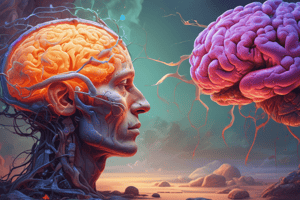Podcast
Questions and Answers
Which sleep stage demonstrates the highest glucose metabolism?
Which sleep stage demonstrates the highest glucose metabolism?
- Wakefulness (correct)
- REM sleep
- NREM sleep
- SWS
What is the primary role of PGO waves in sleep?
What is the primary role of PGO waves in sleep?
- They block sensory input during wakefulness.
- They are responsible for lowering glucose metabolism.
- They activate the neocortex and generate eye movements. (correct)
- They initiate SWS.
Which statement best describes the connectivity of the brain during different sleep stages?
Which statement best describes the connectivity of the brain during different sleep stages?
- SWS shows less connectivity but is more synchronized. (correct)
- Wakefulness has lower brain connectivity compared to all sleep stages.
- NREM sleep has higher connectivity than SWS.
- In REM sleep, brain connectivity is significantly higher than in wakefulness.
What is a key factor in determining sleep quality?
What is a key factor in determining sleep quality?
Which brain areas show increased activation during REM sleep?
Which brain areas show increased activation during REM sleep?
What is the primary function of the VLPO in relation to sleep?
What is the primary function of the VLPO in relation to sleep?
Which system is NOT mentioned as controlling sleep?
Which system is NOT mentioned as controlling sleep?
What neurotransmitter is primarily associated with inhibiting wake-promoting neurons during sleep?
What neurotransmitter is primarily associated with inhibiting wake-promoting neurons during sleep?
What type of EEG pattern is associated with synchronized brain activity during sleep?
What type of EEG pattern is associated with synchronized brain activity during sleep?
What effect does caffeine have regarding adenosine?
What effect does caffeine have regarding adenosine?
What neurotransmitter promotes sleep by its inhibitory action in the brain?
What neurotransmitter promotes sleep by its inhibitory action in the brain?
Which system is involved in determining whether the brain is in a sleep state or awake state?
Which system is involved in determining whether the brain is in a sleep state or awake state?
Which neurotransmitter, when deficient, leads to narcolepsy with cataplexy?
Which neurotransmitter, when deficient, leads to narcolepsy with cataplexy?
What characteristic describes the VLPO's activity during different sleep stages?
What characteristic describes the VLPO's activity during different sleep stages?
Which neurotransmitter is noted for having a complex role in sleep regulation?
Which neurotransmitter is noted for having a complex role in sleep regulation?
Which arousal system is primarily responsible for the generation of arousal in the brainstem?
Which arousal system is primarily responsible for the generation of arousal in the brainstem?
What is the primary role of orexin in the sleep-wake cycle?
What is the primary role of orexin in the sleep-wake cycle?
What distinguishes the ascending arousal system from the sleep-promoting system?
What distinguishes the ascending arousal system from the sleep-promoting system?
What occurs during REM sleep that helps prevent individuals from acting out their dreams?
What occurs during REM sleep that helps prevent individuals from acting out their dreams?
What are sleep spindles indicated to represent in terms of brain activity?
What are sleep spindles indicated to represent in terms of brain activity?
How does the distribution of sleep stages change over the course of a sleep cycle?
How does the distribution of sleep stages change over the course of a sleep cycle?
What is a potential function of sleep spindles mentioned in the content?
What is a potential function of sleep spindles mentioned in the content?
Which statement about the impact of age on sleep spindle activity is correct?
Which statement about the impact of age on sleep spindle activity is correct?
What is the primary function of K complexes during sleep?
What is the primary function of K complexes during sleep?
How do slow waves contribute to memory processing during sleep?
How do slow waves contribute to memory processing during sleep?
What characterizes the brain's activity during REM sleep?
What characterizes the brain's activity during REM sleep?
What does the corticothalamic gating mechanism ensure during sleep?
What does the corticothalamic gating mechanism ensure during sleep?
Which of the following statements about sleep architecture is true?
Which of the following statements about sleep architecture is true?
How do circadian and homeostatic mechanisms interact in regulating sleep?
How do circadian and homeostatic mechanisms interact in regulating sleep?
What is Paradoxical insomnia characterized by?
What is Paradoxical insomnia characterized by?
What phenomenon occurs when a person is sleep-deprived for an extended period?
What phenomenon occurs when a person is sleep-deprived for an extended period?
What is the significance of sawtooth waves observed during sleep?
What is the significance of sawtooth waves observed during sleep?
What is a consequence of gaining homeostatic sleep debt?
What is a consequence of gaining homeostatic sleep debt?
Flashcards are hidden until you start studying
Study Notes
Sleep Architecture and Stages
- REM Sleep: Characterized by brain activity resembling wakefulness; muscle paralysis prevents acting out dreams.
- Physiological Activity: Mostly theta waves with some alpha waves; eyes exhibit saccadic movements supporting the scanning hypothesis.
- Sleep Cycle Dynamics: First half of the night emphasizes slow-wave sleep, while the second half favors REM sleep.
- Homeostatic Pressures: If awakened during deep sleep, sleep cycles re-enter more quickly due to accumulated sleep pressure.
Sleep Microarchitecture
- Sleep Spindles: Bursts of activity representing corticothalamic dialogue; involved in memory consolidation and neuroplasticity.
- K Complex: Spontaneous or evoked patterns in NREM sleep serving as a mechanism for sleep stability and arousal gating.
- Slow Wave Sleep (SWS): Essential for memory consolidation and synaptic homeostasis; occurs primarily in the neocortex.
Neural Regulation of Sleep
- VLPO (Ventrolateral Preoptic Nucleus): Central to sleep regulation, it uses GABA to inhibit wake-promoting systems, becoming more active during NREM and REM.
- Circadian and Homeostatic Systems: Independently influence alertness and fatigue; homeostatic pressure builds with prolonged wakefulness.
Brain Waves and Sleep Quality
- EEG Patterns: Different sleep states identifiable by unique EEG rhythms; interactions between neocortex and subcortical structures crucial for sleep regulation.
- Adenosine: Neuromodulator that inhibits wakefulness; builds up during wakefulness and decreases during sleep, blocked by caffeine.
Dreaming and Cognitive Functions During Sleep
- Dream Stages: Dreams can occur in any sleep stage, but REM is associated with vivid dreams; less correlation between REM and tangible learning.
- Functional Connectivity: Brain connectivity decreases during sleep; SWS involves less connection but more synchronization.
Clinical Implications
- Altered Sleep Patterns: Changes in spindle activity may indicate disorders; sleep architecture varies with age.
- Diagnostics: CAP (Cyclic Alternating Pattern) used to assess sleep stability; insights into insomnia and sleep perception important for treatment.
Sleep as a Process
- Dynamic Nature: Sleep is a series of processes rather than a permanent state; not monolithic and includes varied wakeful states.
- Neural Control: Rise of arousal systems and sleep-promoting systems are interconnected; damage compensation occurs across various networks.
Quality of Sleep
- Importance of SWS: Deep sleep believed to be critical for sleep quality and overall well-being; focus on both consistency and regularity of sleep over mere duration.
Summary of Key Points
- REM sleep and SWS crucial for cognitive functions.
- VLPO regulates sleep through GABA-mediated inhibition of wakefulness.
- Sleep quality heavily influenced by consistency and the presence of deep sleep.
Studying That Suits You
Use AI to generate personalized quizzes and flashcards to suit your learning preferences.





